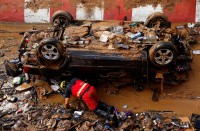REYKJAVIK, Iceland (AFP) — More than 3,000 tremors have shaken seismographs on the northern coast of Iceland over the past three days, the Icelandic Met Office (IMO) said Monday, as officials also warned of an impending volcanic eruption in the south.
Grimsvotn, the most active volcano on the island, appears to be heading for its first eruption since 2011, authorities have warned since mid-June, as high levels of sulphur dioxide indicated the presence of so-called shallow magma.
While an eruption at the Eyjafjallajokull volcano in 2010 caused a huge cloud of smoke and ash that left more than 100,000 flights cancelled and eight million passengers stranded, the effects of this eruption were expected to be less dramatic.
The 2011 Grimsvotn eruption did however lead to the temporary closure of Reykjavik’s Keflavik airport and the cancellation of some 900 flights in Europe, according to aviation organisation Eurocontrol.
As Grimsvotn is located on the northwestern side of the Vatnajokull ice cap, much of the risk during an eruption is actually tied to flooding caused by melting ice.
Meanwhile, on Iceland’s north coast, three quakes that measured over magnitude 5 have been recorded in recent days, one of which was felt in the capital Reykjavik, some 265 kilometres (165 miles) away from the epicentre.
“Compared to previous earthquake swarms in the area it is expected that this swarm will continue during the coming days,” the government institution said.
The epicentre was located 20 kilometres from Siglufjordur, a small village of 1,200 people, and several dozen kilometres from Akureyri, the second-biggest city with almost 20,000 inhabitants.
No major injuries or damage have been reported so far, though some landslides and rock falls have been observed in the area.
The IMO said it could not rule out that the quakes could trigger a larger event.
“But in most cases activity like this ends without a larger event,” it added.
The region is regularly shaken by earthquakes. Located on the Tjornes fracture zone, this geologically active fault line consists of a series of moving tectonic and volcanic zones on the edge of the Mid-Atlantic Ridge.
These recent tremors however come at a time when the country is on alert. Since January, a series of earthquakes have been shaking the area around Grindavik, not far from the popular “Blue Lagoon” hot spring in the Reykjanes Peninsula in Iceland’s south-west corner.
© Agence France-Presse







